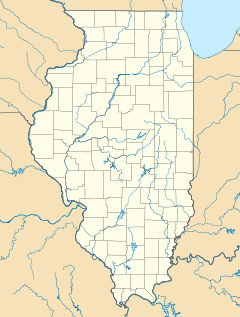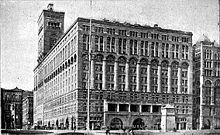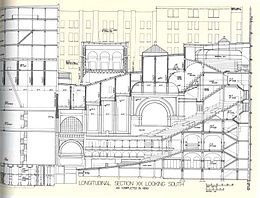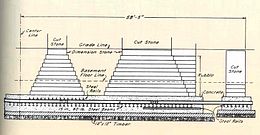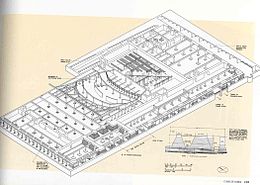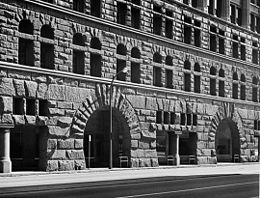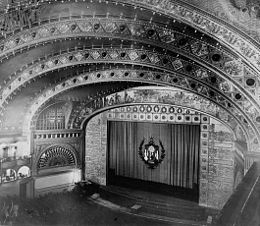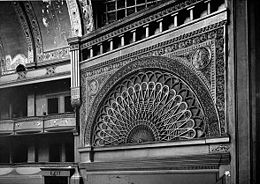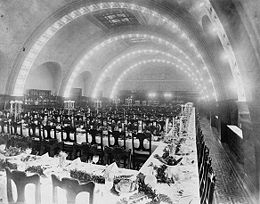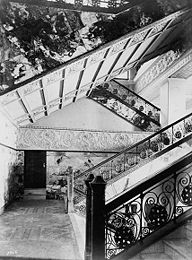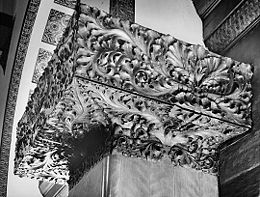- Auditorium Building
-
Auditorium BuildingChicago LandmarkThe Auditorium Building was designed by Dankmar Adler and Louis Sullivan (1886–90).
Location: 430 S. Michigan Ave.
Chicago
Illinois 60605
United StatesCoordinates: 41°52′33.95″N 87°37′30.62″W / 41.8760972°N 87.6251722°WCoordinates: 41°52′33.95″N 87°37′30.62″W / 41.8760972°N 87.6251722°W Built: 1889 Architect: Dankmar Adler; Louis Sullivan Architectural style: Late 19th and Early 20th Century American Movements Governing body: Private NRHP Reference#: 70000230 Significant dates Added to NRHP: April 17, 1970[1] Designated NHL: May 15, 1975[2] Designated CL: September 15, 1976 The Auditorium Building in Chicago is one of the best-known designs of Dankmar Adler and Louis Sullivan. Completed in 1889, the building is located on South Michigan Avenue, at the northwest corner of Michigan Avenue and Congress Parkway. It was declared a National Historic Landmark in 1975.[2] It was designated a Chicago Landmark on September 15, 1976.[3] In addition, it is a historic district contributing property for the Chicago Landmark Historic Michigan Boulevard District.
Since 1947, the Auditorium Building has been the home of Roosevelt University.
The Auditorium Theatre is part of the Auditorium Building and is located at 50 East Congress Parkway. The theater was the first home of the Chicago Civic Opera and the Chicago Symphony Orchestra.
Contents
Origin and purpose
Ferdinand Peck, a Chicago businessman, incorporated the Chicago Auditorium Association in December 1886 to develop what he wanted to be the world's largest, grandest, most expensive theater that would rival such institutions as the Metropolitan Opera House in New York City. He was said to have wanted to make high culture accessible to the working classes of Chicago.
The building was to include an office block and a first class hotel. Peck persuaded many Chicago business tycoons to go on board with him, including Marshall Field, Edson Keith, Martin Ryerson, and George Pullman. The association hired the renowned architectural firm of Dankmar Adler and Louis Sullivan to design the building. At the time, a young Frank Lloyd Wright was employed at the firm as draftsman.
"The Auditorium was built for a syndicate of businessmen to house a large civic opera house; to provide an economic base it was decided to wrap the auditorium with a hotel and office block. Hence Adler & Sullivan had to plan a complex multiple-use building. Fronting on Michigan Avenue, overlooking the lake, was the hotel (now Roosevelt University) while the offices were placed to the west on Wabash Avenue. The entrance to the auditorium is on the south side beneath the tall blocky eighteen-story tower. The rest of the building is a uniform ten stories, organized in the same way as Richardson's Marshall Field Wholesale Store. The interior embellishment, however, is wholly Sullivan's, and some of the details, because of their continuous curvilinear foliate motifs, are among the nearest equivalents to European Art Nouveau architecture."
—Leland M. Roth. A Concise History of American Architecture. p. 179-80.Some interior details were probably drawn by Frank Lloyd Wright, who started in Sullivan's office as a draftsman in 1887.
— Sir Banister Fletcher. A History of Architecture. p. 1241.Design
Adler and Sullivan designed a tall structure with load-bearing outer walls, and based the exterior appearance partly on the design of H.H. Richardson's Marshall Field Warehouse, another Chicago landmark.[4] The Auditorium is a heavy, impressive structure externally, and was more striking in its day when buildings of its scale were less common. When completed, it was the tallest building in the city and largest building in the United States.[5]
One of the most innovative features of the building was its massive raft foundation, designed by Adler in conjunction with engineer Paul Mueller. The soil beneath the Auditorium consists of soft blue clay to a depth of over 100 feet, which made conventional foundations impossible. Adler and Mueller designed a floating mat of crisscrossed railroad ties, topped with a double layer of steel rails embedded in concrete, the whole assemblage coated with pitch.
The resulting raft distributed the weight of the massive outer walls over a large area. However, the weight of the masonry outer walls in relation to the relatively lightweight interior deformed the raft during the course of a century, and today portions of the building have settled as much as 29 inches. This deflection is clearly visible in the theater lobby, where the mosaic floor takes on a distinct slope as it nears the outer walls. This settlement is not because of poor engineering but the fact the design was changed during construction. The original plan had the exterior covered in lightweight terra-cotta, but this was changed to stone after the foundations were under construction. Most of the settlement occurred within a decade after construction, and at one time a plan existed to shorten the interior supports to level the floors but this was never carried out.
In the center of the building was a 4,300 seat auditorium, originally intended primarily for production of Grand Opera. In keeping with Peck's democratic ideals, the auditorium was designed so that all seats would have good views and acoustics. The original plans had no box seats and when these were added to the plans they did not receive prime locations.
Housed in the building around the central space were an 1890 addition of 136 offices and a 400-room hotel,[5][6] whose purpose was to generate much of the revenue to support the opera. While the Auditorium Building was not intended as a commercial building, Peck wanted it to be self-sufficient. Revenue from the offices and hotel was meant to allow ticket prices to remain reasonable. In reality, both the hotel and office block became unprofitable within a few years.
Design of the Auditorium Building Interior cross-sectionFoundationBasementHistory
On October 5, 1887, President Grover Cleveland laid the cornerstone for the Auditorium Building. The 1888 Republican National Convention was held in a partially finished building where Benjamin Harrison was nominated as a presidential candidate. On December 9, 1889 President Benjamin Harrison dedicated the building and opera star, Adelina Patti, sang ‘Home Sweet Home’ to thunderous applause. Sullivan had also opened his offices on the 16th and 17th floors of the Auditorium tower.
The Chicago Symphony Orchestra debuted on October 16, 1891 and made its home in the Auditorium Theatre until moving to Orchestra Hall in 1904.[5] Theodore Roosevelt gave his famous Bull Moose speech in 1912 at the Auditorium and was nominated for President of the United States by the independent National Progressive Party.
The opera company renting the accommodation moved to the Civic Opera House in 1929, and the Auditorium Theatre closed during the Great Depression. In 1941, it was taken over by the city of Chicago to be used as a World War II servicemen's center. By 1946, Roosevelt University moved into the Auditorium Building,[5] but the theater was not restored to its former splendor.
In 1952, Congress Parkway was widened bringing the curb to the southern edge of the building. To make room for a sidewalk, some ground-floor rooms and part of the theater lobby were removed and a sidewalk arcade created.[7]
On October 31, 1967 the Auditorium Theatre reopened and through 1975, the Auditorium served as Chicago's premier rock venue.
It was declared a National Historic Landmark by the U.S. Department of the Interior in 1975.
The building was equipped with the first central air conditioning system and the theater was the first to be entirely lit by incandescent light bulbs.[5] In 2001, a major restoration of the Auditorium Theatre was begun to return the theater to its original colors and finishes.
Photos of the Auditorium Building Exterior detail of the Auditorium Theatre from Congress ParkwayAuditorium Theatre interior from the balconyInterior detail of the Auditorium TheatreAuditorium Hotel — dining hall from the SouthAuditorium Hotel — detail of the grand stairsGanz Hall capitolNotes
- ^ "National Register Information System". National Register of Historic Places. National Park Service. 2006-03-15. http://nrhp.focus.nps.gov/natreg/docs/All_Data.html.
- ^ a b "Auditorium Building". National Historic Landmark summary listing. National Park Service. http://tps.cr.nps.gov/nhl/detail.cfm?ResourceId=915&ResourceType=Building. Retrieved 2007-10-03.
- ^ "Auditorium Building". City of Chicago Dept. of Pl. and Devpmt., Landmarks Div.. 2003. http://www.ci.chi.il.us/Landmarks/A/Auditorium.html. Retrieved 2007-06-04.
- ^ Sarkowski, John (1956). The Idea of Louis Sullivan. Bulfinch Press. pp. 22. ISBN 0-8212-2667-3.
- ^ a b c d e Henning, Joel (2008-09-06). "Form Follows Function, Elegantly: Louis Sullivan designed the Auditorium Theatre's interior to complement its acoustics-driven shape". Wall Street Journal. Dow Jones & Company, Inc.. http://online.wsj.com/article/SB122064771323104933.html. Retrieved 2008-09-07.
- ^ Carey, Heidi Pawlowski (2005). "Auditorium Building". The Electronic Encyclopedia of Chicago. Chicago Historical Society. http://www.encyclopedia.chicagohistory.org/pages/89.html. Retrieved 2008-09-07.
- ^ http://www.emporis.com/application/?nav=building&lng=3&id=117207
References
- Joseph Siry, "Chicago's Auditorium Building: Opera or Anarchism" Journal of the Society of Architectural Historians 57:2, June 1998.
External links
- Auditorium Theatre
- Images and commentary
- landmark page from the City of Chicago
- Auditorium Building on Emporis
- basic info, an image, and a bibliography
- Broadway In Chicago
- Roosevelt University page about the building
- Postcards from the Past (a slide show)
- Auditorium Theater Programs at The Newberry Library
U.S. National Register of Historic Places Topics Lists by states Alabama • Alaska • Arizona • Arkansas • California • Colorado • Connecticut • Delaware • Florida • Georgia • Hawaii • Idaho • Illinois • Indiana • Iowa • Kansas • Kentucky • Louisiana • Maine • Maryland • Massachusetts • Michigan • Minnesota • Mississippi • Missouri • Montana • Nebraska • Nevada • New Hampshire • New Jersey • New Mexico • New York • North Carolina • North Dakota • Ohio • Oklahoma • Oregon • Pennsylvania • Rhode Island • South Carolina • South Dakota • Tennessee • Texas • Utah • Vermont • Virginia • Washington • West Virginia • Wisconsin • WyomingLists by territories Lists by associated states Other  Category:National Register of Historic Places •
Category:National Register of Historic Places •  Portal:National Register of Historic Places
Portal:National Register of Historic PlacesChicago Loop Theater District Cadillac Palace Theatre · Chicago Theatre · Goodman Theatre · Harris Theater · Jay Pritzker Pavilion · Joffrey Tower · Bank of America Theatre · Oriental Theatre
South Loop Theatres
Auditorium Theatre · Merle Reskin Theatre · Petrillo Music ShellChicago Landmark skyscrapers National Historic Landmark,
National Register of Historic Places,
Chicago LandmarkNational Register of Historic Places,
Chicago LandmarkChicago Landmark 330 North Wabash · 333 North Michigan · 35 East Wacker · Allerton Hotel · Brooks Building · Bryn Mawr Apartment Hotel · Carbide & Carbon Building · Chicago Building · Civic Opera House · Heyworth Building · Inland Steel Building · London Guarantee Building · Mather Tower · New York Life Insurance Building · Old Dearborn Bank Building · Palmer House · Powhatan Apartments · Pittsfield Building · Richard J. Daley Center · Tribune Tower
See Also Apartments · Culture · Education · Historic Districts · Houses · Memorials and Monuments · Municipal · Skyscrapers · Transportation · Worship Chicago Landmark cultural venues National Historic Landmark,
National Register of Historic Places,
Chicago LandmarkAuditorium Building, Lorado Taft Midway StudiosNational Historic Landmark,
National Register of Historic PlacesNational Register of Historic Places,
Chicago LandmarkBiograph Theater · Chicago Cultural Center · Chicago Theatre · Fine Arts Building · Former Chicago Historical Society Building · Uptown TheatreChicago Landmark Civic Opera Building · Congress Theater · Field Museum of Natural History · Harris and Selwyn Theaters · Museum of Science and Industry · Navy Pier Headhouse and Auditorium · New Regal Theater · Pui Tak Center · South Side Community Art Center · Sunset Cafe · Thalia Hall · Yondorf Block and HallApartments · Culture · Education · Historic Districts · Houses · Memorials and Monuments · Municipal · Skyscrapers · Transportation · Worship Categories:- Chicago school (architecture)
- Buildings and structures completed in 1889
- American architecture
- Historic district contributing properties
- Landmarks in Chicago, Illinois
- Louis Sullivan buildings
- National Historic Landmarks in Illinois
- National Register of Historic Places in Chicago, Illinois
- Roosevelt University
- Skyscrapers in Chicago, Illinois
- Theatres in Chicago, Illinois
- Concert halls in the United States
- Visitor attractions in Chicago, Illinois
Wikimedia Foundation. 2010.


